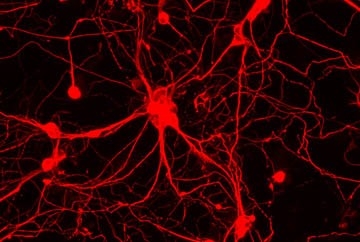Imagine you’ve just stopped your car at the top of the steepest street in San Francisco. Now, if want to stay at the top of the hill you’re going to need to keep your foot on the brakes. Let go and you’ll start rolling down. Fast.
Conceptually, similar decision points happen in human development. A brain cell, for instance, has the DNA instructions to become any cell in the body but must “keep the brakes on”, or repress, genes responsible for other cell types. Release the silencing of those genes and the brain cell’s properties will get pulled toward other fates.
That’s the subject of a CIRM-funded research study published today in Nature which reports on the identification of a new type of repressor protein which opens up a new understanding of how brain cells establish and keep their identity. That may not sound so exciting to our non-scientist readers but this discovery could lead to new therapy approaches for neurological disorders like autism, schizophrenia, major depression and low I.Q.
Skin cells to brain cells with just three genes
In previous experiments, this Stanford University research team led by Marius Wernig, showed it’s possible to convert a skin cell to a brain cell, or neuron, by adding just three genes to the cells, including one called Myt1l. The other two genes were known to act as master “on switches” that activate a cascade of genes responsible for making neuron-specific proteins. Myt1l also helped increase the efficiency of this direct reprogramming but it’s exact role in the process wasn’t clear.
A closer examination of Myt1l protein function revealed that instead of being an on switch for neuron-specific genes, it was actually an off switch for skin-specific genes. Now, there’s nothing unusual about the existence of a protein that represses gene activity to help determine cell identity. But up until now, these repressors were thought to be “lineage specific” meaning they specifically switched off genes of a specific cell type. For example, a well-studied repressor called REST affects cell fate by putting the brakes on only nerve-specific genes. The case of Myt1l was different.
Many but one
The researchers found that, in brain cells, Myt1l not only blocked the activation of skin-specific genes, it also shut down genes related to lung, cartilage, heart and other cells fates. The one set of genes that Mytl1 repressor did not appear to act on was neuron-specific genes. From these results a “many but one” pattern emerged. That is; it seems Myt1l helps drive and maintain a neuron cell fate by shutting off gene networks for many different cell identities except for neurons. It’s a novel way to regulate cell fate, as Wernig explained in a press release:
“The concept of an inverse master regulator, one that represses many different developmental programs rather than activating a single program, is a unique way to control neuronal cell identity, and a completely new paradigm as to how cells maintain their cell fate throughout an organism’s lifetime.”
To build a stronger case for Myt1l function, the team looked at the effect of blocking the protein in the developing mouse brain. Sure enough, lifting Myt1l repression lead to a decrease in the number of neurons in the brain. Wernig described the impact of also inhibiting Myt1l in mature neurons:
“When this protein is missing, neural cells get a little confused. They become less efficient at transmitting nerve signals and begin to express genes associated with other cell fates.”
Potential cures can be uncovered withfundamental lab research
It turns out that Myt1l mutations have been recently found in people with autism, schizophrenia, major depression and low I.Q. Based on their new insights, the author suggest that in adults, these disorders may be caused by a neuron’s inability to maintain its identity rather than by a more permanent abnormality that occurred during fetal brain development. This hypothesis presents the exciting possibility of developing therapies that could improve symptoms.


